The Inland Mariners: Special / R/V Kiyi
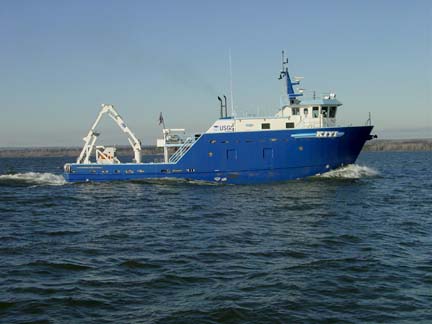 R/V Kiyi |
The
research vessel Kiyi, operated by the Lake Superior Biological
Station at Ashland, Wisconsin, makes an annual circumnavigation
of the lake as part of an ongoing census of fish populations in
Lake Superior. |
|
R/V
Kiyi Length:
107 feet |
|
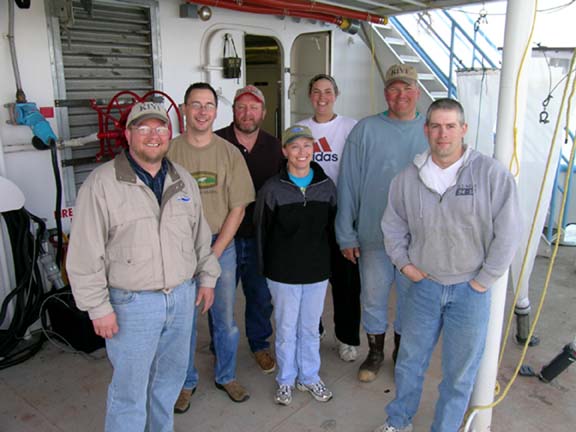
|
The
crew of the Kiyi consists of a combination of fishery biologists
and the vessel's navigation team. |
|
The
primary mission of the spring lake survey is to gather census information
on forage fish populations around the lake. This is accomplished
using a trawl net at predermined "stations" along the
shore. |
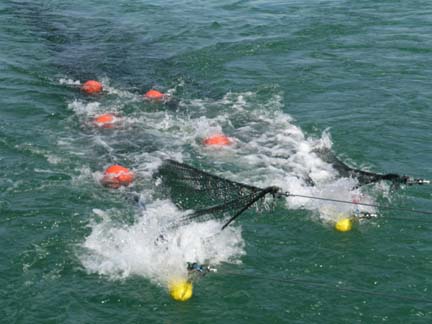 Trawl net being pulled back to the Kiyi |
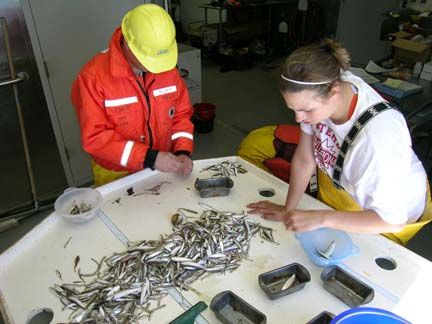 Sorting fish in the Wet Lab (Black Bay, Ontario) |
Once the fish are aboard the vessel they are sorted by species, counted, weighed, and measured in the vessel's Wet Lab. |
| The information gathered at each trawling station is cataloged and recorded in the Kiyi's Dry Lab. Once the Kiyi has returned to its home base in Ashland the data is then entered into the LSBS's database and made available to fishery managers and researchers. |
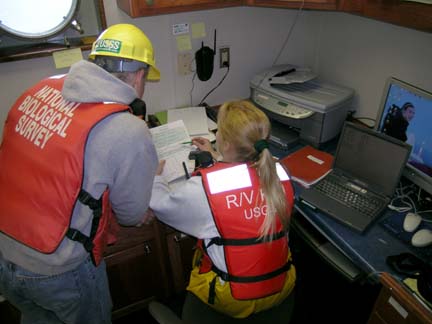 Analyzing information in the Dry Lab |
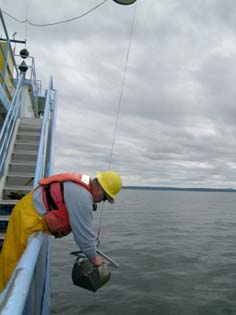 Ponar Grab at Rainboth Point |
The biologists are interested in not only the fish population, but what the fish each as well. Deck
foreman Keith Peterson (L) prepares for a "ponar grab,"
lowering the clamshell device that will grab a soil sample from
the lake bottom. Biological Technician Lori Evrard (R) collects zooplankton samples gathered off Thunder Bay's Pie Island. The samples are preserved for study back at the research station. |
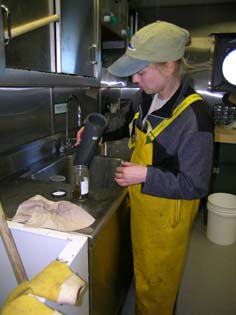 Zooplankton sample |
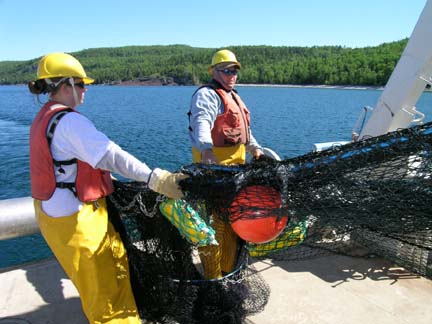 Setting the trawl net at Red Rock |
The
crew of the Kiyi works four to five stations each day, averaging
about twelve hours work from start to finish, rain or shine. Deck
foreman Keith Peterson, and Northland College biology student Lindsey
Lesmeister prepare to set the trawl net at Station 454, Red Rock
River Bay, Ontario. |
|
To maintain the integrity of the data each trawl, or "transect" is laid out on exact coordinates, with a specified distance, course, and depth. In the pilot house Captain Joe Walters and First Mate Mike McCann are in constant communicatin with the trawl deck as they monitor each transect. |
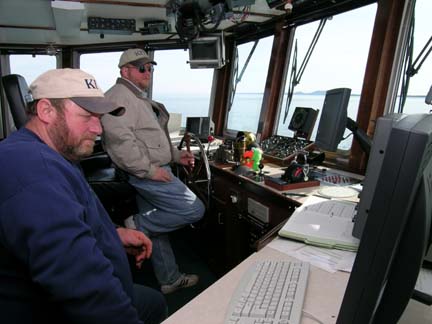 Captain Walters (R) and Mike McCann (L) in Black Bay. |
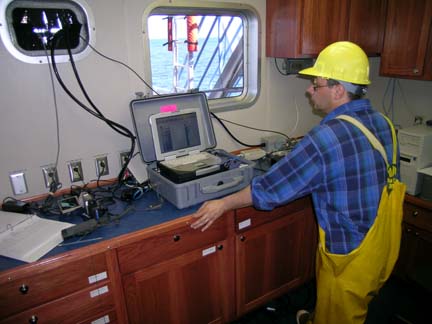 Dan Yule monitors the hydroacoustic data during a transect |
In addition to the annual census the biologists also conduct research based on their particular areas of interest. Fishery biologist Dan Yule is a specialist in the use of hydroacoustics and is using sonar to study the forage fish populations in Lake Superior. On each transect, for instance, Dan monitors the hydroacoustic data and then compares it against the fish census gathered from the trawl. |
| Jason Stockwell, the Kiyi's lead biologist on this trip, is working on a pilot study of the lake's forage fish biomass. The purpose of the study is to more accurately determine the forage fish populations in the lake, information that fishery managers need to help regulate commercial and recreational fishing, while protecting the lake's natural resources. |
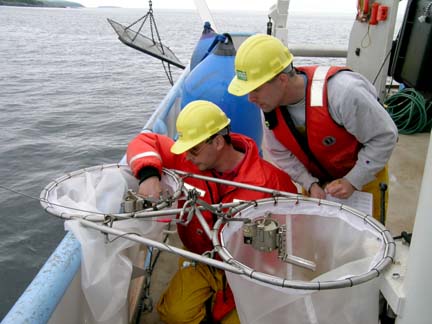 Dan (L) Jason (R) preparing Zooplankton nets at Jackfish Bay |
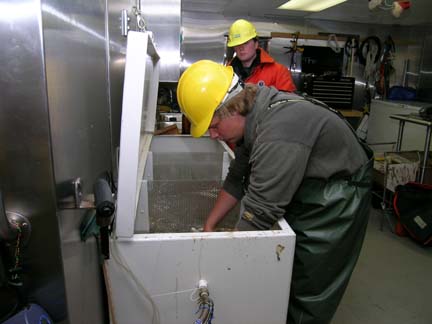 The Kiyi's 700 gallon live well is used to hold fish until they can be released back into the lake. |
Dan Katajamaki and Russ Bobrowski, students working for the Ontario Ministry of Natural Resources out of Thunder Bay jumped at the chance to spend a day on the lake aboard the Kiyi. |
|
L-R Marcel
Pellegrini Stephen
Chong |
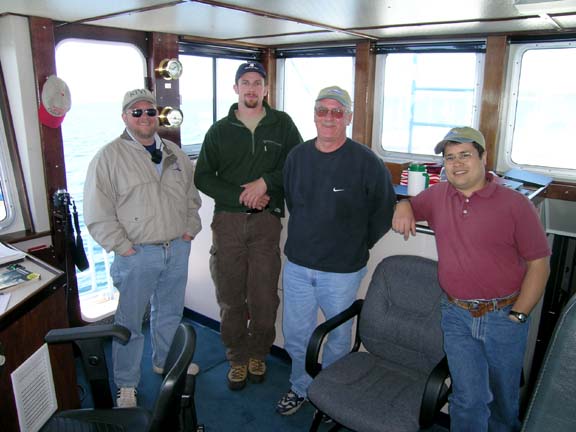 Ontario Ministry of Natural Resources visitors |
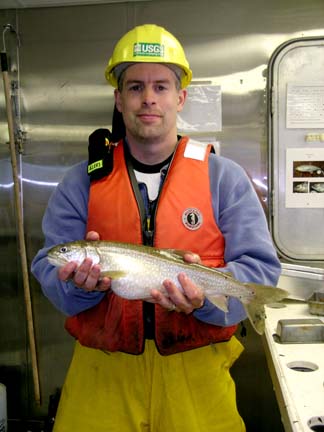 |
The lake trout, once nearly decimated by over fishing and the predatory sea lampray has made a tremendous return to Lake Superior, in a large part due to the efforts of the program conducted by the Lake Superior Biological Station, a field station operated by the Great Lakes Science Center in Ann Arbor, Michigan. |
| The lake herring is one of the primary food sources for mature lake trout. A healthy forage fish population, which includes fish such as herring, smelt, bloater, and kiyi, is important to maintaining a balanced Lake Superior fishery. |
 Herring at Sawyer Bay, Thunder Bay, Ontario |
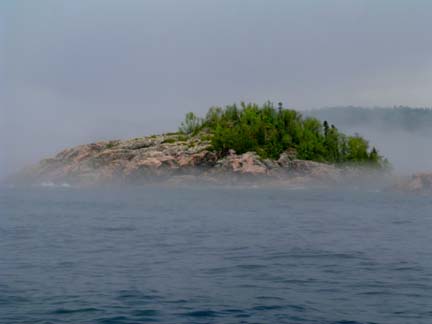 Station 466: Richardson's Harbor |
The days are long and the work is never ending, the spectacular scenery of Lake Superior manages to weave its way into every day. While the biologists are focused specifically on fish, the lake's entire ecosystem is always considered when it comes to managing our natural resources. |
| Le
Pate, at 860 meters, towers above the lake as the Kiyi approaches
Station 403. |
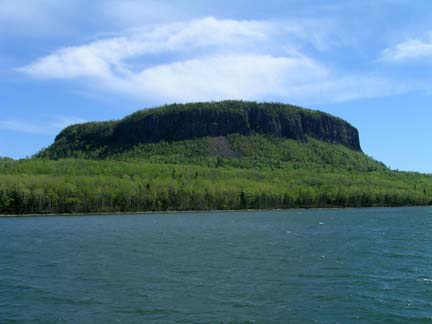 Station 403: Pie Island |
 Anchorage: MacGregor Cove |
The
sun sets behind Vrooman Island,
in the tranquility of McGregor Cove on the eastern shore of Lake
Superior. |
 Lori Evrard Biological Technician |
 Joe Walters Captain |
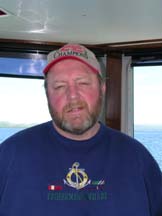 Mike McCann First Mate |
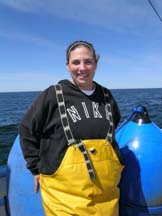 Lindsey Lesmeister Biology Student |
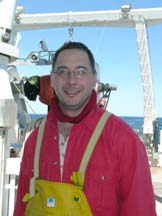 Dan Yule Fishery Biologist |
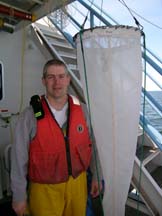 Jason Stockwell Fishery Biologist |
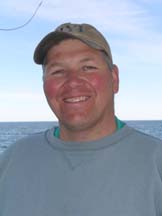 Keith Peterson Engineer |
Special thanks to the crew of
the R/V Kiyi |
